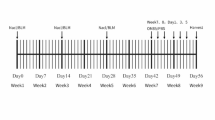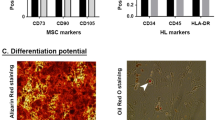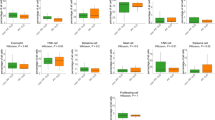Abstract
Aim:
To study the in vivo effects of Quin-C1, a highly specific agonist for formyl peptide receptor 2 (FPR2/ALX), in a mouse model of bleomycin (BLM)-induced lung injury.
Methods:
Male ICR mice were injected intratracheally with BLM (d 0), and intraperitoneally with Quin-C1 (0.2 mg/d) or vehicle between d 1 and d 28, during which pulmonary inflammation was monitored. A similar regimen was carried out between d 5 and d 28 to differentiate anti-inflammatory from anti-fibrotic effects. During the treatment, leukocyte numbers in bronchoalveolar lavage fluid (BALF) were counted, and FPR2/ALX transcripts, tumor necrosis factor α (TNF-α), interleukin-1β (IL-1β), the mouse keratinocyte-derived chemokine (KC), transforming growth factor β1 (TGF-β1) and C-X-C motif chemokine 10 (CXCL10) expression levels in the lung tissue were also measured. Both hydroxyproline content and histological changes were examined on d 28 to assess the severity of lung fibrosis.
Results:
BLM caused a significant increase in expression levels of all the selected cytokines and chemokines, as well as a thickening of the alveolar wall. Treatment with Quin-C1 significantly reduced the neutrophil and lymphocyte counts in BALF, diminished expression of TNF-α, IL-1β, KC, and TGF-β1, and decreased collagen deposition in lung tissue. The treatment also lowered the content of lung hydroxyproline. Quin-C1 did not ameliorate lung fibrosis when the treatment was started 5 d after the BLM challenge, suggesting that the protection may be attributed to its anti-inflammatory effects. Exposure to BLM or BLM plus Quin-C1 did not change the level of FPR2/ALX transcripts (mFpr1, mFpr2, and Lxa4r) in the lung tissue.
Conclusion:
The results demonstrate an anti-inflammatory role for Quin-C1 in bleomycin-induced lung injury, which may be further explored for therapeutic applications.
Similar content being viewed by others
Log in or create a free account to read this content
Gain free access to this article, as well as selected content from this journal and more on nature.com
or
References
Migeotte I, Communi D, Parmentier M . Formyl peptide receptors: a promiscuous subfamily of G protein-coupled receptors controlling immune responses. Cytokine Growth Factor Rev 2006; 17: 501–19.
Rabiet MJ, Huet E, Boulay F . Human mitochondria-derived N-formylated peptides are novel agonists equally active on FPR and FPRL1, while Listeria monocytogenes-derived peptides preferentially activate FPR. Eur J Immunol 2005; 35: 2486–95.
Ye RD, Boulay F, Wang JM, Dahlgren C, Gerard C, Parmentier M, et al. International Union of Basic and Clinical Pharmacology. LXXIII. Nomenclature for the formyl peptide receptor (FPR) family. Pharmacol Rev 2009; 61: 119–61.
Fiore S, Maddox JF, Perez HD, Serhan CN . Identification of a human cDNA encoding a functional high affinity lipoxin A4 receptor. J Exp Med 1994; 180: 253–60.
Serhan CN . Lipoxins and aspirin-triggered 15-epi-lipoxins are the first lipid mediators of endogenous anti-inflammation and resolution. Prostaglandins Leukot Essent Fatty Acids 2005; 73: 141–62.
Chiang N, Serhan CN, Dahlen SE, Drazen JM, Hay DW, Rovati GE, et al. The lipoxin receptor ALX: potent ligand-specific and stereoselective actions in vivo. Pharmacol Rev 2006; 58: 463–87.
Schaldach CM, Riby J, Bjeldanes LF . Lipoxin A4: a new class of ligand for the Ah receptor. Biochemistry 1999; 38: 7594–600.
Dufton N, Hannon R, Brancaleone V, Dalli J, Patel HB, Gray M, et al. Anti-inflammatory role of the murine formyl-peptide receptor 2: ligand-specific effects on leukocyte responses and experimental inflammation. J Immunol 2010; 184: 2611–9.
Nanamori M, Cheng X, Mei J, Sang H, Xuan Y, Zhou C, et al. A novel nonpeptide ligand for formyl peptide receptor-like 1. Mol Pharmacol 2004; 66: 1213–22.
Le Y, Gong W, Li B, Dunlop NM, Shen W, Su SB, et al. Utilization of two seven-transmembrane, G protein-coupled receptors, formyl peptide receptor-like 1 and formyl peptide receptor, by the synthetic hexapeptide WKYMVm for human phagocyte activation. J Immunol 1999; 163: 6777–84.
Adamson IY, Bowden DH . The pathogenesis of bloemycin-induced pulmonary fibrosis in mice. Am J Pathol 1974; 77: 185–97.
Chua F, Gauldie J, Laurent GJ . Pulmonary fibrosis: searching for model answers. Am J Respir Cell Mol Biol 2005; 33: 9–13.
Moore BB, Hogaboam CM . Murine models of pulmonary fibrosis. Am J Physiol Lung Cell Mol Physiol 2008; 294: L152–60.
Phan SH, Kunkel SL . Lung cytokine production in bleomycin-induced pulmonary fibrosis. Exp Lung Res 1992; 18: 29–43.
Keane MP . The role of chemokines and cytokines in lung fibrosis. Eur Respir Rev 2008; 17: 151–6.
Waseda Y, Yasui M, Nishizawa Y, Inuzuka K, Takato H, Ichikawa Y, et al. Angiotensin II type 2 receptor antagonist reduces bleomycin-induced pulmonary fibrosis in mice. Respir Res 2008; 9: 43.
Reddy GK, Enwemeka CS . A simplified method for the analysis of hydroxyproline in biological tissues. Clin Biochem 1996; 29: 225–9.
Pua ZJ, Stonestreet BS, Cullen A, Shahsafaei A, Sadowska GB, Sunday ME . Histochemical analyses of altered fetal lung development following single vs multiple courses of antenatal steroids. J Histochem Cytochem 2005; 53: 1469–79.
Wang ZG, Ye RD . Characterization of two new members of the formyl peptide receptor gene family from 129S6 mice. Gene 2002; 299: 57–63.
Southgate EL, He RL, Gao JL, Murphy PM, Nanamori M, Ye RD . Identification of formyl peptides from Listeria monocytogenes and Staphylococcus aureus as potent chemoattractants for mouse neutrophils. J Immunol 2008; 181: 1429–37.
Cheever AW, Dunn MA, Dean DA, Duvall RH . Differences in hepatic fibrosis in ICR, C3H, and C57BL/6 mice infected with Schistosoma mansoni. Am J Trop Med Hyg 1983; 32: 1364–9.
Kanekal S, Fraiser L, Kehrer JP . Pharmacokinetics, metabolic activation, and lung toxicity of cyclophosphamide in C57/B16 and ICR mice. Toxicol Appl Pharmacol 1992; 114: 1–8.
Branton MH, Kopp JB . TGF-beta and fibrosis. Microbes Infect 1999; 1: 1349–65.
Sheppard D . Transforming growth factor beta: a central modulator of pulmonary and airway inflammation and fibrosis. Proc Am Thorac Soc 2006; 3: 413–7.
Gurujeyalakshmi G, Wang Y, Giri SN . Taurine and niacin block lung injury and fibrosis by down-regulating bleomycin-induced activation of transcription nuclear factor-kappaB in mice. J Pharmacol Exp Ther 2000; 293: 82–90.
Inayama M, Nishioka Y, Azuma M, Muto S, Aono Y, Makino H, et al. A novel IkappaB kinase-beta inhibitor ameliorates bleomycin-induced pulmonary fibrosis in mice. Am J Respir Crit Care Med 2006; 173: 1016–22.
Matsuoka H, Arai T, Mori M, Goya S, Kida H, Morishita H, et al. A p38 MAPK inhibitor, FR-167653, ameliorates murine bleomycin-induced pulmonary fibrosis. Am J Physiol Lung Cell Mol Physiol 2002; 283: L103–12.
Yara S, Kawakami K, Kudeken N, Tohyama M, Teruya K, Chinen T, et al. FTS reduces bleomycin-induced cytokine and chemokine production and inhibits pulmonary fibrosis in mice. Clin Exp Immunol 2001; 124: 77–85.
Hamaguchi Y, Nishizawa Y, Yasui M, Hasegawa M, Kaburagi Y, Komura K, et al. Intercellular adhesion molecule-1 and L-selectin regulate bleomycin-induced lung fibrosis. Am J Pathol 2002; 161: 1607–18.
Helene M, Lake-Bullock V, Zhu J, Hao H, Cohen DA, Kaplan AM . T cell independence of bleomycin-induced pulmonary fibrosis. J Leukoc Biol 1999; 65: 187–95.
Okazaki T, Nakao A, Nakano H, Takahashi F, Takahashi K, Shimozato O, et al. Impairment of bleomycin-induced lung fibrosis in CD28-deficient mice. J Immunol 2001; 167: 1977–81.
Chen ES, Greenlee BM, Wills-Karp M, Moller DR . Attenuation of lung inflammation and fibrosis in interferon-gamma-deficient mice after intratracheal bleomycin. Am J Respir Cell Mol Biol 2001; 24: 545–55.
Belperio JA, Dy M, Burdick MD, Xue YY, Li K, Elias JA, et al. Interaction of IL-13 and C10 in the pathogenesis of bleomycin-induced pulmonary fibrosis. Am J Respir Cell Mol Biol 2002; 27: 419–27.
Daniels CE, Wilkes MC, Edens M, Kottom TJ, Murphy SJ, Limper AH, et al. Imatinib mesylate inhibits the profibrogenic activity of TGF-beta and prevents bleomycin-mediated lung fibrosis. J Clin Invest 2004; 114: 1308–16.
Strieter RM, Gomperts BN, Keane MP . The role of CXC chemokines in pulmonary fibrosis. J Clin Invest 2007; 117: 549–56.
Tager AM, Kradin RL, LaCamera P, Bercury SD, Campanella GS, Leary CP, et al. Inhibition of pulmonary fibrosis by the chemokine IP-10/CXCL10. Am J Respir Cell Mol Biol 2004; 31: 395–404.
O'Meara SJ, Rodgers K, Godson C . Lipoxins: update and impact of endogenous pro-resolution lipid mediators. Rev Physiol Biochem Pharmacol 2008; 160: 47–70.
Vaughn MW, Proske RJ, Haviland DL . Identification, cloning, and functional characterization of a murine lipoxin A4 receptor homologue gene. J Immunol 2002; 169: 3363–9.
Chen K, Le Y, Liu Y, Gong W, Ying G, Huang J, et al. A critical role for the G protein-coupled receptor mFPR2 in airway inflammation and immune responses. J Immunol 2010; 184: 3331–5.
Walther A, Riehemann K, Gerke V . A novel ligand of the formyl peptide receptor: annexin I regulates neutrophil extravasation by interacting with the FPR. Mol Cell 2000; 5: 831–40.
Bae YS, Park JC, He R, Ye RD, Kwak JY, Suh PG, et al. Differential signaling of formyl peptide receptor-like 1 by Trp-Lys-Tyr-Met-Val-Met-CONH2 or lipoxin A4 in human neutrophils. Mol Pharmacol 2003; 64: 721–30.
Machado FS, Johndrow JE, Esper L, Dias A, Bafica A, Serhan CN, et al. Anti-inflammatory actions of lipoxin A4 and aspirin-triggered lipoxin are SOCS-2 dependent. Nat Med 2006; 12: 330–4.
Godson C, Mitchell S, Harvey K, Petasis NA, Hogg N, Brady HR . Cutting edge: lipoxins rapidly stimulate nonphlogistic phagocytosis of apoptotic neutrophils by monocyte-derived macrophages. J Immunol 2000; 164: 1663–7.
Romano M, Maddox JF, Serhan CN . Activation of human monocytes and the acute monocytic leukemia cell line (THP-1) by lipoxins involves unique signaling pathways for lipoxin A4 versus lipoxin B4: evidence for differential Ca2+ mobilization. J Immunol 1996; 157: 2149–54.
Burli RW, Xu H, Zou X, Muller K, Golden J, Frohn M, et al. Potent hFPRL1 (ALXR) agonists as potential anti-inflammatory agents. Bioorg Med Chem Lett 2006; 16: 3713–8.
Martins V, Valenca SS, Farias-Filho FA, Molinaro R, Simoes RL, Ferreira TP, et al. ATLa, an aspirin-triggered lipoxin A4 synthetic analog, prevents the inflammatory and fibrotic effects of bleomycin-induced pulmonary fibrosis. J Immunol 2009; 182: 5374–81.
Acknowledgements
We are indebted to Xiang MENG, Xiao-yan WU, and Hao-ran SU for technical assistance. This work was supported in part by grants from the Ministry of Science and Technology of China (2009ZX09302-001), Shanghai Municipality government (08430703200 and 09DZ2291200) and the National Institutes of Health, USA (AI033503).
Author information
Authors and Affiliations
Corresponding author
Additional information
Supplementary figure is available at Acta Pharmacologica Sinica website of NPG.
Supplementary information
Supplementary Figure 1
Effects of late administration of Quin-C1 on BLM-induced lung injury in mice. (DOC 204 kb)
Rights and permissions
About this article
Cite this article
He, M., Cheng, N., Gao, Ww. et al. Characterization of Quin-C1 for its anti-inflammatory property in a mouse model of bleomycin-induced lung injury. Acta Pharmacol Sin 32, 601–610 (2011). https://doi.org/10.1038/aps.2011.4
Received:
Accepted:
Published:
Issue date:
DOI: https://doi.org/10.1038/aps.2011.4
Keywords
This article is cited by
-
Formyl peptide receptor 2, as an important target for ligands triggering the inflammatory response regulation: a link to brain pathology
Pharmacological Reports (2021)
-
Anti-inflammatory signaling through G protein-coupled receptors
Acta Pharmacologica Sinica (2020)
-
Adh enhances Actinobacillus pleuropneumoniae pathogenicity by binding to OR5M11 and activating p38 which induces apoptosis of PAMs and IL-8 release
Scientific Reports (2016)
-
Synthesis and antioxidant activity of new analogs of Quin-C1
Chemistry of Heterocyclic Compounds (2013)



